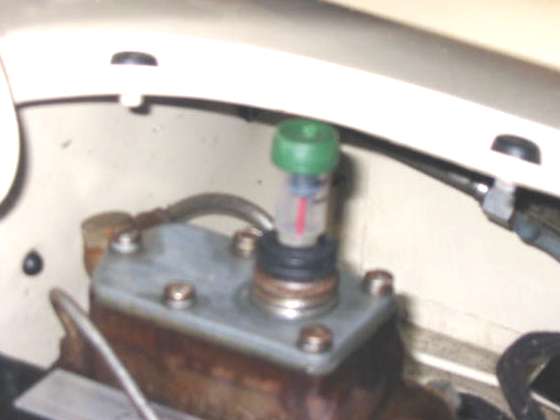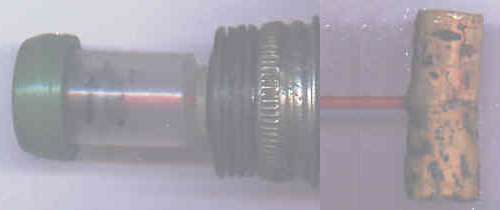The MGA With An Attitude
FLUID LEVEL INDICATOR for the Master Cylinder - HT-202
#1 Mechanical
At 08:49 AM 11/16/04 -0500,Roger Bailey wrote:
>"I now have a float indicator on my brake fluid reservoir. I found the level annoyingly awkward to see and measure. Out of sight, out of mind. Then I discovered the level was a LOT lower than I had expected when I got round to checking it, so an invention was called for. Works great: open the bonnet and there it is."
At 09:44 AM 11/17/04 -0500, Roger Bailey wrote:
>"The brake system on the A is obviously crude and completely without backup. I must confess that I don't take the time to unscrew the cap on the reservoir every time I am under the bonnet, and try (futily) to gauge the level. I do, however, glance at my new indicator, just as I glance at the see-through tanks on my regular cars. Attached is the (fuzzy) snapshot of a brake fluid indicator." (Will try for a better picture later).

This simple effort uses two 7/16" tapered bottle corks, shortened enough at the small end to allow for complete rotation within the reservoir, pinned and epoxied together, bow-tie fashion, with the minor diameter ends together. The cork assy is coated overall with epoxy. The metal cap holes are enlarged to allow the passage of a red spray tube from a carb-cleaner to pass through. The plastic is serrated / barbed, epoxied, and inserted in a press-fit hole drilled in the cork bow tie, across the minor diameter. (i.e., the cork floats horizontally in the tank). Two O-rings are glued to the metal cap, and bushed down to accept the business end of a cut down syringe. There is a nylon disk pushed onto the
red tube to act as a sight indicator. Min level was marked by removing 30 cc's of fluid from the official tank level. (Still over 3/8" above the divider in the tank.) Max level marked conversely. A vented plastic cap is pushed over the sawed off syringe.

Although fluid can still be added easily by way of a syringe by loosening the cap, the width of the (necessary) cork configuration prevents removing the cap altogether (although one could always remove the lid). There may be other notions for enough flotation, but this is the only configuration I found that provides enough weight / force to make the indicator track the fluid without hanging up and/or not permitting enough level change to be useful.
Cheers,
Roger
|